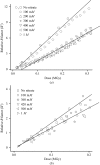Can radiation damage to protein crystals be reduced using small-molecule compounds?
- PMID: 21931220
- PMCID: PMC3176623
- DOI: 10.1107/S0907444911032835
Can radiation damage to protein crystals be reduced using small-molecule compounds?
Abstract
Recent studies have defined a data-collection protocol and a metric that provide a robust measure of global radiation damage to protein crystals. Using this protocol and metric, 19 small-molecule compounds (introduced either by cocrystallization or soaking) were evaluated for their ability to protect lysozyme crystals from radiation damage. The compounds were selected based upon their ability to interact with radiolytic products (e.g. hydrated electrons, hydrogen, hydroxyl and perhydroxyl radicals) and/or their efficacy in protecting biological molecules from radiation damage in dilute aqueous solutions. At room temperature, 12 compounds had no effect and six had a sensitizing effect on global damage. Only one compound, sodium nitrate, appeared to extend crystal lifetimes, but not in all proteins and only by a factor of two or less. No compound provided protection at T=100 K. Scavengers are ineffective in protecting protein crystals from global damage because a large fraction of primary X-ray-induced excitations are generated in and/or directly attack the protein and because the ratio of scavenger molecules to protein molecules is too small to provide appreciable competitive protection. The same reactivity that makes some scavengers effective radioprotectors in protein solutions may explain their sensitizing effect in the protein-dense environment of a crystal. A more productive focus for future efforts may be to identify and eliminate sensitizing compounds from crystallization solutions.
Figures




References
-
- Audette-Stuart, M., Houée-Levin, C. & Potier, M. (2005). Radiat. Phys. Chem. 72, 301–306.
-
- Barker, A. I., Southworth-Davies, R. J., Paithankar, K. S., Carmichael, I. & Garman, E. F. (2009). J. Synchrotron Rad. 16, 205–216. - PubMed
-
- Blake, C. & Phillips, D. C. (1962). Proceedings of the Symposium on the Biological Effects of Ionising Radiation at the Molecular Level, pp. 183–191. Vienna: International Atomic Energy Agency.
-
- Borek, D., Ginell, S. L., Cymborowski, M., Minor, W. & Otwinowski, Z. (2007). J. Synchrotron Rad. 14, 24–33. - PubMed
-
- Box, H. C. (1972). Annu. Rev. Nucl. Sci. 22, 355–382.
Publication types
MeSH terms
Substances
Grants and funding
LinkOut - more resources
Full Text Sources

